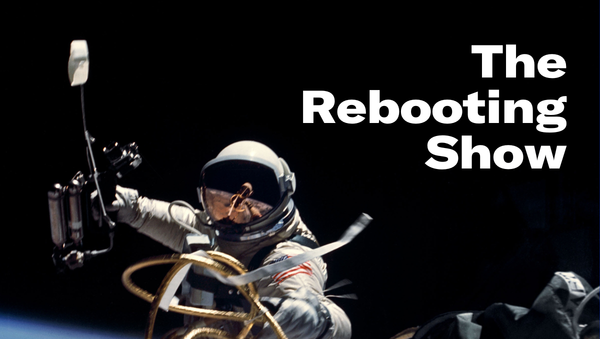Digital advertising's data reset
Audigent's Jake Abraham on why many publishers stand to benefit from the demise of the third-party cookie
Welcome to this week’s edition of The Rebooting Show. This week’s episode is a sponsored Spotlight episode, where I feature a conversation with a sponsor of The Rebooting in order to get a better understanding of their approach to solving a challenge of building sustainable media businesses. The way these work is I agree on a general topic with the sponsor – how data plays an important role in building sustainable media businesses, in this case – and then the episodes are like any other. My goal is to make these as valuable and informative as any other episode. Please let me know your feedback – and get in touch if you’d like to sponsor upcoming mini-seasons on the creator economy, newsletters, subscriptions and more. My email is bmorrissey@gmail.com.

The entire tech industry is going through a broad reckoning over the collection, storage and use of consumer data. Government regulations, Apple’s new data policies, the demise of the third-party cookie and other market pressures are changing how a large chunk of advertising works. Look no further than Facebook’s historic stock price meltdown after disappointing results it blamed, in part, to new obstacles to targeting and measuring ads.
“We get a reset that gives the industry an opportunity to rethink a lot of things,” said Jake Abraham, chief commercial officer of Audigent, a data platform that works with publishers to better understand their audiences and turn that understanding into achieving business goals. “While it’s messy in the middle, ultimately we come out with a [situation where] the publisher is the source of truth, more transparency, better privacy and more tools to actually do what both advertisers and publishers want.”
Below are highlights of the conversation Jake and I had about how publishers need to think of their audience data as an asset class, the false dichotomy between contextual advertising and addressable advertising, and how Facebook gets small businesses hooked.
The negative impact of rampant data collection
The only people in the world who use the term “personalized advertising” are those who work in ad tech. For the rest of humanity, this is ad targeting or, increasingly, “surveillance advertising.” The backlash against the use of data in advertising is somewhat curious since there are seemingly far more worrying data trends, particularly how governments are using data sets, but likely ties back to the chaotic, complicated way digital advertising works in the hopes of getting the right ad in front of the right person.
“Publishers are victims often. Their margins are squeezed harder than ever before. As the technology evolves, there's more and more middlemen. It's very hard in this ecosystem to understand the technology, and understand how those middlemen might be using the data and taking a vig on the transaction. Some of the [intermediaries] are super important. But there are plenty of others that, in a pretty unregulated industry, have found a way to insert themselves and arbitrage. And while that may not be illegal, it certainly doesn't provide a lot of value.”
Not all middlemen are bad
If digital advertising has an original sin, it’s likely the ability to separate the audience impression from the media. This was a nifty trick. After all, if you had a fly-fishing reel for left-handed anglers, you’d need to try to find them in a fly-fishing publication whose readers are overwhelmingly right handed. Internet advertising would solve that problem by enabling advertisers to find these lefty fly fishers wherever they are, a process that takes many parties and where the value often isn’t placed on the media where the ad is delivered.
“I still see all the time the meme around how much of an advertising dollar goes back to the publisher when it's three pennies. That's somewhat misguided. It's the same thing as saying, how much of a cup of coffee goes back to the producer? There's a lot of people in the chain that provide value between the guy that puts the plant in the ground and the barista who's actually grinding your cappuccino. The question becomes how do we ensure that those that are taking their handout are providing value back to the publisher and hopefully to the advertiser.”
Beyond cookies
At this point, few debate that the days of the third-party cookie playing an important role in digital advertising are ending. That much is clear, but what is unclear is what will take its place. Google has recently overhauled its approach to lean on a “topics” approach. For publishers, the emerging rules of the road could be a net benefit as the value of first-party data rises.
“One of the things that's been hard to date is that there are certain giant platforms that have dominated. We know 79% of all non-search advertising goes to three different platforms. We want to create a scenario where we can have liquidity around data, meaning the ability to use it in the ecosystem democratically, whether it's a publisher or an advertiser.”
“What we say to publishers all the time is that the next publisher isn't your enemy; that next publisher is your partner in this larger ecosystem. We operate as a cooperative, meaning that a lot of publishers can collaborate on data in order to achieve scale. We see over 2 billion devices. We have the ability to certainly play in the scale game. A niche player and individual advertiser may not have massive scale, but that doesn't mean that they don't have partnerships and tool sets to be able to still deliver the way they need to.”
Context + audience
An impact of the shift to primary-engagement media is a greater value being placed on context. This has a back to the future quality to it, since context has always been a vitally important signal for matching ads to audiences. But pretty much since the start of the internet, context has taken a back seat to “addressable” advertising that seeks to find specific individuals to match to specific ad messages. This has proven to be very lucrative, as evidenced by the valuation of Google and Facebook.
“There’s a sweet spot I call contextual-plus, where the context of the page is critically important. We want to be able to deliver other important things about that audience and that's what creates added value. We think that we can do it in ways that will be future-proofed so that regardless of how platforms evolve, regardless of how privacy evolves, there will continue to be ways to deliver something more than just contextual. I’m not taking anything away from contextual – it's an important part of what we do – but what more can we add so that we can provide more value and have our publishers getting a leg up.”
First-party data beyond email
When ad tech events are fully up and running every week of the year, expect “first-party data” to get marked off quickly on your Buzzword Bingo card. Like much of programmatic, first-party data is both critical and poorly understood.
“First-party data is just a term. Different publishers have different types of first-party data. There’s a bit of a misnomer that first-party data has to be an email address. First-party data can be lots of things. First-party data means it’s collected by the content owner. The publisher is collecting their own audience’s data. In the third=party space, it was different ways of collecting the data, where it was not the publisher collecting that data. So first-party data can come from a number of different mechanisms.”
Facebook’s challenge
Jake and I spoke prior to Facebook’s disastrous earnings report. But our conversation touched on one of the drivers of Facebook’s challenges: Apple’s move to restrict the use of data in ad targeting has exposed Facebook’s core of small advertisers.
“As the targeting changes on Facebook and, we have small businesses coming to us all the time saying, “My first 10,000 customers on Facebook; it was crazy. We did it for like a $2 CPA and then suddenly we hit 10,000 users and hit a brick wall.” That's not by accident. That's by design. You’re inside a platform and totally subject to their algorithms and their models. And that's great that they can get you hooked that way. What we're banking on is the idea that we'll be able to use an open ecosystem and open data to help smaller businesses continue to find value. And they won't always be able to find it in addressable [advertising], where it might be more expensive. If we're doing our jobs right on the buy side, we should absolutely be able to continue to drive value when a combination of context and targeting can provide what we couldn't provide before.”


5 things to check out
Alex Kantrowitz of Big Technology and I discussed publishing’s next evolution and the upsides and downsides of going solo. Alex has a great Substack for understanding where the tech industry is going next — and he understands the ad industry.
Peter Kafka invited me onto the Recode Media podcast to discuss entrepreneurial publishing, particularly the need for the Roaring 20s to go beyond just funding those focused on affluent, powerful people.
Mark Sternberg at Adweek has a nice profile of Industry Dive, one of the unheralded success cases of building a sizable and sustainable digital publishing business. As I told Mark, Sean Griffey and team have simply executed very well. Lotta times people try to make the publishing business more complicated than it is.
Spotify’s Joe Rogan controversy continues onto a third week. Spotify CEO Daniel Ek has vowed to earmark $100 million to music and audio from underrepresented groups as the latest kerfuffle is over Rogan’s use of racial epithets in some of his earlier episodes. Lucas Shaw of Bloomberg runs through Ek’s not very palatable options. In the end, exclusively licensing content is different than acting as a neutral platform that hosts third-party content.
Solving local news is the hardest problem in sustainable media. Clare Malone of The New Yorker examines the roles non-profit groups are playing in backing local news projects. The problem: There’s not enough money to fill the hole left with the decimation of the local newspaper industry.

Thanks for reading and listening. Shoot me a note with feedback: bmorrissey@gmail.com.




